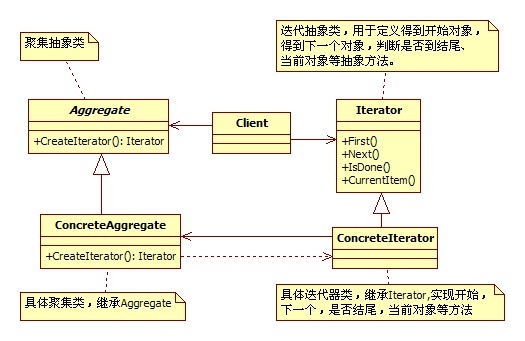Home >Backend Development >PHP Tutorial >Iterator pattern and its php implementation (Yii framework)
Iterator pattern and its php implementation (Yii framework)
- 伊谢尔伦Original
- 2016-12-01 13:05:571296browse
The iterator pattern is a behavioral pattern, which is the simplest and most common design pattern. It allows users to inspect each element in the container through a specific interface without knowing the actual underlying operation.
Applicability
When you want to use the traversal function of the language itself to facilitate custom structures, such as the foreach function in PHP
Class diagram

PHP instance
<?php
class sample implements Iterator {
private $_items ;
public function __construct(&$data) {
$this->_items = $data;
}
public function current() {
return current($this->_items);
}
public function next() {
next($this->_items);
}
public function key() {
return key($this->_items);
}
public function rewind() {
reset($this->_items);
}
public function valid() {
return ($this->current() !== FALSE);
}
}
// client
$data = array(1, 2, 3, 4, 5);
$sa = new sample($data);
foreach ($sa AS $key => $row) {
echo $key, ' ', $row, '<br />';
}
?>implementation in Yii framework:
in In the Yii framework, we can see the implementation of its iterator. In the CMapIterator.php file in the collections directory, the implementation is as follows:
class CMapIterator implements Iterator {
/**
* @var array the data to be iterated through
*/
private $_d;
/**
* @var array list of keys in the map
*/
private $_keys;
/**
* @var mixed current key
*/
private $_key;
/**
* Constructor.
* @param array the data to be iterated through
*/
public function __construct(&$data) {
$this->_d=&$data;
$this->_keys=array_keys($data);
}
/**
* Rewinds internal array pointer.
* This method is required by the interface Iterator.
*/
public function rewind() {
$this->_key=reset($this->_keys);
}
/**
* Returns the key of the current array element.
* This method is required by the interface Iterator.
* @return mixed the key of the current array element
*/
public function key() {
return $this->_key;
}
/**
* Returns the current array element.
* This method is required by the interface Iterator.
* @return mixed the current array element
*/
public function current() {
return $this->_d[$this->_key];
}
/**
* Moves the internal pointer to the next array element.
* This method is required by the interface Iterator.
*/
public function next() {
$this->_key=next($this->_keys);
}
/**
* Returns whether there is an element at current position.
* This method is required by the interface Iterator.
* @return boolean
*/
public function valid() {
return $this->_key!==false;
}
}
$data = array('s1' => 11, 's2' => 22, 's3' => 33);
$it = new CMapIterator($data);
foreach ($it as $row) {
echo $row, '<br />';
}Compared with the previous simple implementation, the change of its position is by controlling the key. Implemented, the purpose of this implementation is to avoid being unable to iterate when false is used as an array value.

